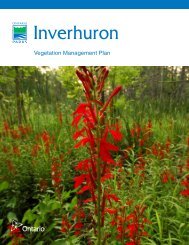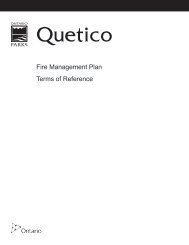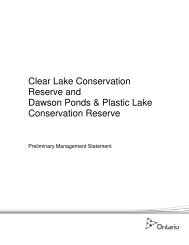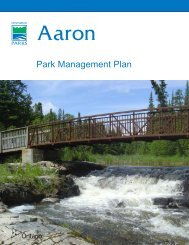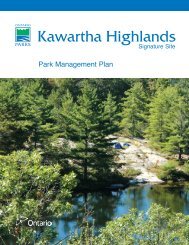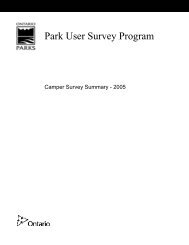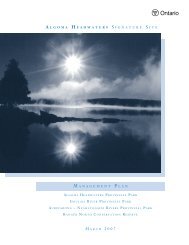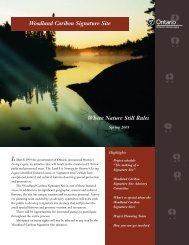Sandbanks Draft Veg Mgmt Plan - Ontario Parks
Sandbanks Draft Veg Mgmt Plan - Ontario Parks
Sandbanks Draft Veg Mgmt Plan - Ontario Parks
Create successful ePaper yourself
Turn your PDF publications into a flip-book with our unique Google optimized e-Paper software.
APPENDIX E – Invasive Species Information Sheets<br />
strangling Vine has not yet invaded alvar communities in the SEZ, these communities<br />
should be closely monitored for invasions. Pale Swallow-wort is associated with calcareous<br />
soils, and this may also be true of Black Swallow-wort (Lawlor, 2001). The habitat in which it<br />
is found in parks has not been fully described.<br />
Dispersal: Wind dispersed.<br />
Impacts<br />
Dog-strangling Vine can form dense stands that exclude and may displace native vegetation<br />
- further research is needed to determine the impact of this on native plant communities<br />
(Lawlor, 2001). Toxic substances present in this species may also have allelopathic<br />
(suppress the growth of other species) properties.<br />
Laboratory trials have shown that Monarch butterflies (Danaus plexippus) will use Black<br />
Swallow-wort as an alternate host to lay their eggs on, rather than the native milkweeds.<br />
Larvae found on Black Swallow-wort experience high levels of mortality. It is possible that<br />
Monarch butterflies may also oviposit on Pale Swallow-wort. It is not yet known how and to<br />
what extent this may affect Monarch populations (Lawlor, 2001).<br />
Control Measures<br />
• Mechanical methods have not proven successful (Lawlor, 2001; McKewan, 2002;<br />
Cappuccino, 2002, Towel, 2002; Christensen, 1998). Both mowing and digging may<br />
actually stimulate growth (Cappuccino, 2002). Digging has the added disadvantage of<br />
disturbing the soil, which may promote more vigorous growth from the seed bank. If root<br />
crowns are dug up, they must be removed from the site, as crowns left on the ground<br />
can re-sprout (Lawlor, 2001) Mowing may be partially successful if this is carried out until<br />
the seed bank is depleted, but the site will need to be completely restored afterwards.<br />
Christensen (1998) found that repeated mowing reduced the average stem height, but<br />
did not have a great effect on total cover. Mowing should be carried out twice per<br />
growing season: once in mid-June, and again in early August.<br />
• Hand-pulling is not recommended, as root crown fragments in the soil will re-sprout<br />
(Lawlor, 2001).<br />
• Mulching has been attempted with both leaf litter and plastic sheeting. A common<br />
problem with this method is that animals will tear the sheeting, and plants can push<br />
through the mulch. Unless a tear resistant fabric can be utilized, this method is not<br />
recommended (Christensen, 1998). Again, this method kills all plants below the mulch or<br />
sheeting, and plastic sheeting can also kill soil microbes.<br />
• Fire may not be effective at reducing the number of mature plants in a colony, but may<br />
be useful after chemical application to remove seedlings, but further research is needed<br />
to substantiate this (Lawlor, 2001).<br />
• Chemical control is the most effective method (Lawlor, 2002; Christensen, 1998;<br />
McKewan). Glyphosate is recommended, as it is not persistent in the soil, and has a low<br />
level of toxicity in animals with no long term negative effects. Triclopyr has been tested<br />
on this species, and results were not as high as plants treated with glyphosate (Lawlor,<br />
2002). Foliar spraying of herbicides appears to be the most successful application<br />
method, but this is only practical in monocultures. Cut-stem application (wicking stems<br />
and leaves of trimmed plants) provides species specific control, and is recommended in<br />
areas where the goal is to release surrounding vegetation. A 5% solution of glyphosate is<br />
required for foliar spraying, and a 50%+ solution for cut-stem application. This dosage is<br />
higher than recommended by the manufacturer. Application should be done at the bud<br />
<strong>Sandbanks</strong> <strong>Veg</strong>etation Management <strong>Plan</strong> A-17<br />
<strong>Ontario</strong> <strong>Parks</strong>, SE Zone<br />
2009





